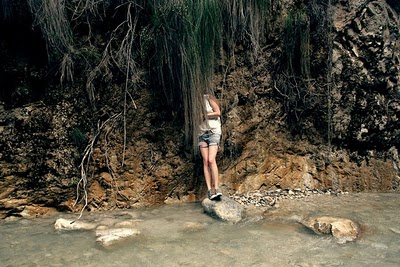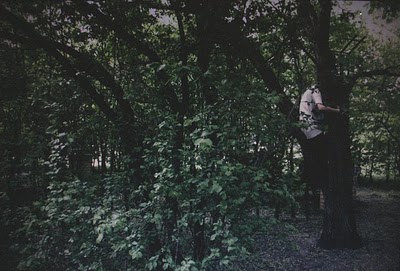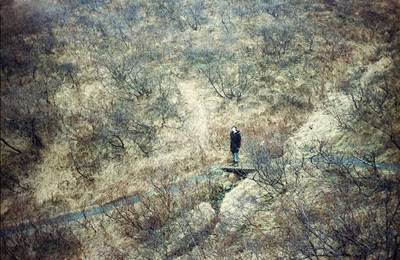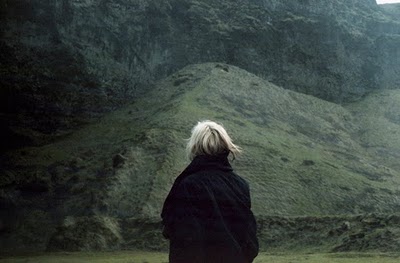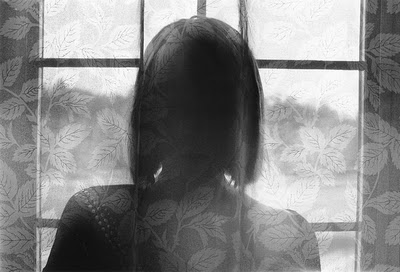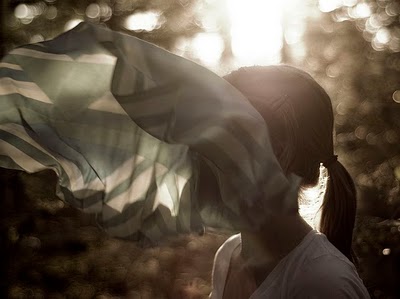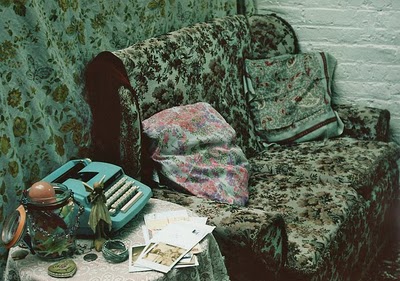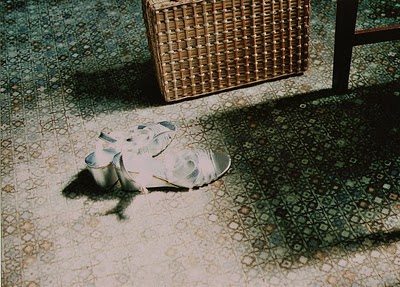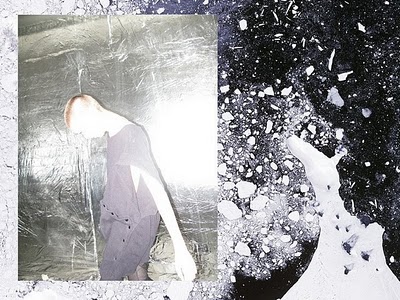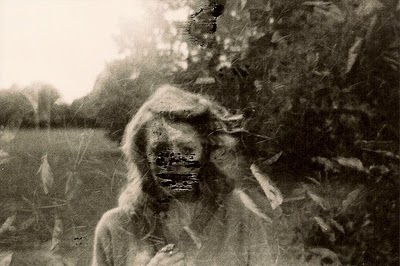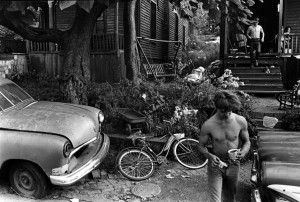
Patricia Gruben: Sifted Evidence (an interview) (1994)
Patricia Gruben has been telling stories for two decades now, but they are tales unlike any others. Her movies favour characters who are not quite characters — they appear as survivors of some terrible catastrophe. And as we look into their blank gaze for clues, wishing we could stroll past the film’s beginning and catch a glimpse of this primal disaster, but knowing all the while we can’t, we are left finally with ourselves. How do we tell stories? And how do the stories we tell finally narrate ourselves? These questions are fundamental in Gruben’s shaken universe. In her three feature films and pair of shorts, Gruben stages our ability to “make” sense. Her passive leads try to negotiate a universe which has been wiped clean, and which attempts to begin again using a rational discourse. Over and over, Gruben invokes a scientific rhetoric — in The Central Character’s blueprints, Sifted Evidence’s books of anthropology, and Low Visibility’s observational testings — all in hopes of conjuring an absent subjectivity. That science may finally prove just one more story we tell ourselves is a fear that underlines much of her musings. Each of her films invites us to the border, where laws have not yet formed around our speaking, and where a change in ideas might hinge on a change in prose.
PG: I went to film school at the University of Texas hoping to make political documentaries. But I realized eventually that the documentary form began with an acceptance of what went on in front of the camera. That’s when I realized that I had to work in fiction. I found I couldn’t make political fiction films either because they tended to promote an ideology first, and it was difficult for me to combine that with aesthetic motives. I felt I had to make a choice between politics and aesthetics. My interest in film and human behaviour is more exploratory than didactic, more a question of how we know what we know, or how we do what we do. If I start to make a film, even if it begins with a political issue, it often charts its own course, and I have to follow.
MH: How did you arrive in Canada?
PG: Originally I came up to visit an old boyfriend from Texas, an army deserter. I’d just quit film school and was working in Houston for a little production company that was rapidly going bankrupt. I flew into Toronto at Christmas and saw snow for the first time — as a kid I’d read all these books about how Christmas was supposed to look and Houston in December never fit the picture. Toronto seemed to me a perfect place to start a life as a filmmaker because it seemed everyone was starting in 1972, and there was money available for people to work as artists in film in a way that wasn’t possible in the US.
Back in Houston, people kept sending me issues of the original Take One, and one was devoted exclusively to women’s films, a pretty rare topic in 1972. Two women from Toronto were mentioned in that issue — Barbara Martineau contributed an article and filmmaker Sylvia Spring gave an interview. I wrote them both about my intentions of coming to Toronto, and they invited me to call. Shortly afterwards, we became friends. They took me on as a kind of “project,” introducing me to people, Barbara in the academic community, and Sylvia in production. In 1973, I worked with the organizers of the first Women’s Film Festival, who brought together a global community of sorts, but it quickly dispersed after the festival. Then Sylvia Spring organized a women’s collective called “From Under Films.” She had a strong feminist agenda, but the others were a pretty mixed group of people. This collective of would-be filmmakers worked for over a year trying to find a way to make political work. The main project was based on a Joanna Russ novel, a science fiction story about a woman from the future who switches places with a woman in the present. The future was founded on communal ideals which abolished the inequalities of gender, but I found it deadly boring because everything about this future society needed to be more progressive than the present. Utopian societies don’t interest me much. I spent a year trying to meet the agenda of this women’s collective and failed. Our projects were aimed at the upcoming International Women’s Year and that’s when I discovered how the government is behind all artistic activity in Canada. [laughs] I got a real good education in writing grant applications, but we never received funding. I felt confused, that I wasn’t on the right track, and after a year or so the group dissolved. I was trying to write screenplays for the CBC, which weren’t moving, and doing props on feature films. It wasn’t until 1976 that I started making films again, my first personal work since school.
I’d actually started making The Central Character (16 min b/w 1977) in 1974, and I was quickly bogged down with the same problems the group had. I just wanted to make a little fifteen-minute experimental film, although at that time it was much more of a narrative. There was a group of women who were trying to get started in the film industry and decided they would help me make this movie. There was a producer from CBC who brought in a still photographer, catering, assistant directors — mostly women who hadn’t really worked in film yet, but wanted to. All this for a movie with one character! It completely overwhelmed me and I just stopped shooting in the middle of production because we were using a Hollywood model for making a very intuitive film. I abandoned it for a year before re-shooting the whole thing myself.
I was reading a book by John Jaynes called The Origins of Consciousness and the Breakdown of the Bicameral Mind, a popular book in the mid-seventies which dealt with the development of ego/self consciousness. But I wanted this film to show a devolution of self consciousness, that it would turn its back on a history which is typically described in terms of a progressive, evolutionary ascent. The Central Character began with someone who felt herself as a rational, decision-making being, who kept order in the house. Her domestic duties — sweeping, cooking, cleaning — mapped out an orderly universe that was every bit as measured as the portions in a recipe. But her life of utility is slowly eroded until, in the end, she’s completely overtaken by natural forces, swallowed by the surrounding forest. As I talk, I realize I’ve done this at least three times in films and probably will continue to do so. In the end, the character goes somewhere the audience can’t follow and we have to say goodbye, to let them pass. It also happens at the end of Low Visibility, and towards the end of Sifted Evidence. The Central Character shows a woman leaving the civilized world and entering the natural world, and along the way her civilized constructions are broken down. The final shot of the film shows a drawing of a tree with the woman’s face inside it. So while she’s disappeared into that tree, we’re left behind, only able to look at it as a drawing, because her destination is something we can’t experience. Towards the end, she leaves home in search of plant containers, dropping seeds behind to make a trail she can follow back home. But these are eaten by birds, which makes her return impossible. What she finds in her search is a junkyard universe, a heap of objects overgrown with weeds. She takes up a radio but finds it’s only capable of broadcasting static. These last remnants of civilization pre-figure her blending into the forest, lost in a world she never made.
MH: Tell me about Sifted Evidence (42 min 1982).
PG: Sifted Evidence shows a woman telling the story of a trip to Mexico. In a sense, the whole film is a flashback, but one which is obviously re-enacted. The dramatic sequences are largely shot in front of a front-screen, so you always get the sense of a flattened, bordered image people speak in front of, like a series of picture postcards. She goes to Mexico searching for the source of these prehistoric, two-headed clay fertility figures. On her trip she meets a black American man who assures her he knows where they are, and she becomes entangled with him. They proceed through a number of misunderstandings, with the woman feeling trapped inside a culture, a language, and now a relationship she doesn’t understand. They have a last quarrel before she leaves him sleeping in a chair. She goes to the quarry and finds, not the statues she’s after, but the debris of her own civilization. The film’s opening and closing are set in her apartment in a kind of present time, where the objects on display provide the evidence of her travelling. But these artifacts are just signifiers; they’re not the thing itself. The film ends with a freeze on her open mouth, as there’s no real resolution to the film, no last word.
MH: She’s cast as a researcher throughout the film — whether browsing archeology texts or learning language records; everything in the film, including her personal experience, seems to be a part of an ongoing academic project. But apart from recounting her own misadventures, there’s little sense of what she’s able to finally make of all this research.
PG: What she’s looking for is little characters with two heads, an image of herself perhaps. She’s literally split — there are three voices for this character. The first voice delivers the documentary style information at the beginning; the second is the more personalized voice which carries us through the body of the dramatic narrative; and the third is the German voice in her mind which speaks of her own personal, cultural, and historical past. This last only comes to her in fragments of poetry and free association. She speaks early in the film about her German origins, and the mind/body split particular to German culture and philosophy. Her trip is a failed attempt to resolve this duality.
In the quarry she hears a Rilke poem from the ninth “Duino Elegy” and, for me, that’s the point where the character undergoes an experience we can’t follow, like the end of The Central Character or Low Visibility. She begins to recognize her own cultural history, her German roots, instead of being diverted by Mexico’s archeology. In the late seventies, a lot of women, including myself, were trying to recoup a sense of our own history, and felt we had to go back to a sense of prehistory, to a matrilineal, pre-literate society where women were gods, and fertility was the most important attribute a human could have. This woman travels to Mexico to experience some of these elemental forces but finds the baggage of a classical university education standing in her way. Instead of being able to resolve her duality, she winds up experiencing it in a more profound way because she’s come to a place whose culture and history are foreign to her. She finds herself caught between the demands of a patriarchal culture and the expectations of a liberal education. This induces a kind of stasis in the character, where she’s able to do very little but record what’s happening.
MH: Much of her recounting is set before front-screen projections. These backdrops relate to layers of memory and the archeology metaphors that run through the film. Can you talk more about the front-screen?
PG: She carries a camera much of the time and some of the photos she takes wind up on the front-screen. They never show people; instead they look at Coke bottles on a window ledge, or two lawn chairs sitting after their occupants have left. All of her photos show objects people have used; they’re evidence that people have passed this way, but aren’t there any longer. The backdrops are unpeopled, and the actors enter into them as a kind of afterthought. As well, because the film is based on her reconstructions, I wanted to make it clear that we’re watching a movie. There’s a double frame: the frame of the movie itself and the frame of her story. I was interested in exaggerating the boundaries of the film screen, of making us aware of its flatness. In live theatre, one of the biggest problems is getting people on and off stage. In film, you have the luxury of cutting into a scene with everyone already there — you don’t have to watch them walk away. In this film I wanted those entrances and exits to be explicit.
MH: Most of the film is taken up with recreated scenes of the couple together, stalling her pursuit of the ruins. Can you say something about these two?
PG: His name’s Jim Lilly, a completely made-up character in the sense that he’s constructed himself. He tells her one story about himself and then another in contradiction. He’s someone whose greatest sense of worth resides in his relations with others. At one point he says to her, “I’m a people person. You don’t know people because you’ve got your head in a book all the time. That’s why you don’t see what’s going on around you. We drove right past your ruins on the way here and you didn’t even notice.” Because of her own conflict, she studies people instead of relating to them. She’s also caught in the bind of travelling in a country which holds very traditional views of women. If she isolates herself completely and never takes a chance on a stranger, all she’s done is kept herself from getting robbed or raped. So each individual has to find a balance, to go wild like the Jackie Burroughs character in A Winter Tan, or go half-way like Sifted Evidence.
MH: Both characters seem caught in their own stories, two monologues sharing a space. She seems in search of the words to be able to tell her own story — she can only describe herself in terms of her reactions to outside events, books, ideas. On the other hand, he seems to have told his story so often the words have become fluid, his own story interchangeable with others around him.
PG: There is that split. She doesn’t care what he tells her so long as it’s interesting and she’s not endangered. She’s got a kind of an academic approach to relationships, as if she’s surveying people, the way writers eavesdrop in a coffee shop, waiting for something to be revealed that they can turn into art. In a sense she’s travelling to gather material, and he doesn’t understand that idea.
MH: The entire narrative is related in voice-over except for the last scene in which we see the two of them in the same space. It’s set in her hotel room where he breaks in: they argue, and he pins her to the bed before taking up a bedside vigil. He eventually falls asleep, and she escapes to the quarry. But their argument breaks into sync sound, whereas the rest of the film is voice-over.
PG: I wanted to distance the audience from the story she’s telling by reversing the conventions of realism. Their argument comes about 37 minutes into a 42 minute film, so people have grown used to the voice-over and accepted it as natural. The sync sound comes as a shock, and I had this perverse desire to point out that it was as artificial as any other filmmaking technique. I also used it for its emotional shock value to underscore their argument. I don’t like making films where women really get hurt, so I wanted to suggest violence without making it physical. After he’s pinned her to the bed, we hear him speaking for the first time. For the first several minutes in the film she describes what he says, after which she recites the dialogue for both of them. You see his lips moving, but she’s doing all the talking.
MH: In a hotel close to the ruins, he tells her the exact moment he falls in love with her — like the narratives of Christian conversion that obsessively detail the precise moment their life changes forever.
PG: He tells her he’s fallen in love with her and she asks him when it happened. She’s inadvertently sparked an emotional response that seems false to her, so she’s trying to work out what kind of character he is. I think of Low Visibility, where everyone is trying to understand a man who remains opaque to them. Both of these characters are opaque to one another, trapped within images they’ve learned long before they met, and these images make it impossible for them to speak. He represents the adventure she wants to have in Mexico. She represents a North American class and style he’s learned from advertising. Just before his love confession, he asks why she’s wearing a bikini because that dress isn’t appropriate here. That hearkens back to the old question women have: do I dress to please myself or to meet expectations? Or is pleasing myself just fulfilling other’s expectations because I know I look good in this and want to be admired? Every question feminists struggled with in the seventies is contained in this film — the bikini question, the shave your legs question, or whether it’s politically correct to wear make-up. The issue of cliché gets back to seeing ourselves from outside, regarding yourself as others do. The cliché is what we know about the unknown; it maps our sense of ourselves onto our surroundings. But what happens when this sense comes from outside, from a culture that assigns women tools of understanding that don’t necessarily fit with our experience? The woman in Sifted Evidence is caught inside these images; her passivity stems from not being able to work out these contradictions.
MH: Was there a community in Toronto that helped support, critique, exhibit your work?
PG: In the seventies there was a group of people working in the avant-garde who weren’t interested in narrative, and others who wanted to “go Hollywood” and beat their heads against the wall. I didn’t know anyone apart from myself who crewed features while making films in the other camp. I didn’t seem to fit any place. Today a community committed to independent drama exists in Toronto, but it didn’t then. There’s a new generation now, and the gap between drama and the avant-garde seems less distinct. Back then there were too many worlds that didn’t connect, and I didn’t want to look back at a life of doing props for B-movies. This was at the time I was finishing Sifted Evidence, so all I had was one little movie that had shown around a little and ten years of hauling furniture up and down stairs. I thought perhaps a teaching job would give me access to other people interested in ideas, and I could make money from it. In Vancouver, Simon Fraser University advertised a job which I got in spite of my lack of teaching experience. It’s funny, but in some ways Vancouver is re-enacting in its film community what Toronto went through just after I left. Filmmakers are either working on minuscule budgets at Cineworks (the production co-op), or they’re making popular features for $600,000, or else they’re working for Hollywood. There’s very little overlap.
MH: How do you see the place of formal difference in film?
PG: Each idea has its own ideal form, and the job of the filmmaker is to find the form that best expresses what the film is. I don’t think of my films as formal first; I think of images, and before images as ideas about time or memory or whatever. After these ideas attach themselves to images, a form begins to suggest itself.
MH: After Sifted Evidence the films you produced were features. Was that a conscious decision?
PG: After Sifted Evidence, I wrote Low Visibility which I thought would be about an hour long; I didn’t think I had enough money to make a feature. When it was finished, I didn’t think it could play in commercial theatres or be sold to television. So “feature” is just a length if it doesn’t fit that model of distribution. I think people feel they won’t get any attention paid to them if they don’t make long work, and some funding agencies only support features. Most Canadian feature films get shown in a theatre for a week, have their ACTRA qualifying screenings, and end up on pay-TV to fulfill Canadian content quotas. What bothers me as a teacher is that there’s so little opportunity for people to learn how to make features. Most learn by doing and make mistakes. Ninety minutes is a long time to shape and costs a lot of money, and I don’t think you can make it without the experience of shorter work. I wish there was a cinematic equivalent of the short story, not a conventional drama conforming to the needs of television, but a director’s film.
The government wants an equitable and democratic access to the means of production, so that everyone can make work, so that people who have nothing in common can all enter, and that’s the tension within the co-ops. Everyone gets to belong, but some use it only for equipment on their way to making industrial films, while others want to work in a more artisanal fashion. These different factions are forced to work out their differences in order to gain access to equipment and funding. Doesn’t it make more sense for people to come together because of common ideals and a shared aesthetic? Why not have a group that publishes a manifesto declaring the kind of work that needs to be made, the intention to work collectively to make it, and screw you. Nobody can afford to say “screw you” in this country because there’s always the question of government money. We’re always trying to figure out what the government wants us to do, and that’s no way to make films. You spend your whole life going to meetings.
On the other hand, film is time and time is money. I don’t want to say anything derogatory towards the Canada Council or Telefilm because I grew up in a country that doesn’t have anything like it, and that’s much worse. You have to grant them that they have their own mandate and their own requirements. Saskatchewan’s trying to start up a film industry now, which would be groundless without government funding because the climate’s poor and the population’s low. There’s an artificial quality to the entire initiative.
MH: Isn’t there an artificial quality to the whole of the Canadian independent film sector? Filmmakers receive production monies from Canada Council, who also support production co-ops to provide equipment access. The completed work goes into Council supported distribution co-ops and show in Council supported screening venues. The only people who don’t get paid are the audiences.
PG: But if you call government subsidy artificial, are you saying that the marketplace isn’t? That Ellie Epp’s films should go out there and compete with Batman, and may the best win? Without an exhibition circuit and the advertising dollars that underpin American films, the notion of a level playing field is ridiculous. I can’t blame the government for giving us money. We, as filmmakers, have to take responsibility for our relationship to our money, not to assume that it’s our right to get it, or that there’s no other way to make work.
MH: Tell me about Low Visibility (84 min 1984).
PG: It began as a soap opera about a brain-damaged patient who would be rehabilitated by playing a soap character. But that was too gimmicky. Then a friend told me about a man she knew who’d survived a plane crash in the wild amid rumours of cannibalism. I started poring over old newspaper accounts in the library, researching this guy’s story. They all led up to the inquest and then there was nothing, not a word. So I suspected the news was blacked out. I decided not to contact him or write a film about him in particular, but was intrigued by the idea that all this had happened in isolation, with the only witness unable or unwilling to speak about it. So I started writing the script for Low Visibility. It’s a film that’s finally about filmmaking and empathy. Movies show us events and characters we’re expected to believe in, but if it’s not our story, how do we know whether it’s true? I’m not saying we can’t know, but what sort of tools do we apply to these experiences to test whether they’re authentic or not, and in an extreme case of survival, how can we imagine what that’s like?
Low Visibility is about a man found wandering in a mountain snow storm. He’s taken to a hospital where the staff, a documentary news team, a police detective, and a clairvoyant try to uncover what happened and who he is. The nurses tag him “Mr. Bones” and the name takes. Most of the film is set in the hospital where people have different ideas about what’s wrong with him. Because his only speech is swearing, no one is certain whether he has brain damage, or an emotional disorder, or whether he’s playing dumb to escape prosecution. He undergoes a series of tests and watches TV while the police puzzle out the remains of a plane crash and the half-eaten bodies of its victims. They suspect Mr. Bones of surviving the crash and killing one of the women on board for food, but it’s difficult to come up with enough evidence. The police employ a clairvoyant who is never pictured, but we see everything she sees, and it’s her vision that returns us to the image of the plane crash. Unlike the doctors or the police, she has no structure for the images she recalls, so her evidence is as sketchy as the rest. Finally, he’s released to the detective, who confronts him with what seems to be incontrovertible evidence — a detailed diary found at the site of the plane crash. But in it, the writer speaks of a broken leg, whereas Mr. Bones has no broken joints. The last shot in the film flies over a valley of fog. It’s difficult to understand the scene because it depends on recognizing the voices of two characters — the clairvoyant and the nurse. The clairvoyant has entered the mind of the cannibalized woman, and the nurse has entered the mind of the clairvoyant. The nurse asks the clairvoyant/dead woman, “Did the men ask you whether it’s okay to kill and eat you? Did you tell them yes?” And the clairvoyant/dead woman answers, “I couldn’t talk,” and then, “The blue wings fade and it’s all only blue.” The plane disappears into the fog here; they’re taking off in a psychic sense, entering a place where you don’t need a plane to fly. Because we haven’t gone through what they have, we can’t follow them, so the film has to end there, at the limit of what it’s able to represent.
MH: Shortly after arriving in the hospital, one of the doctors explains that a video system will keep the patient in constant view. It recalled for me Jeremy Bentham’s panopticon prison in which the prisoner is kept under an unrelieved surveillance. The desired effect is to manufacture a kind of internal surveillance, a conscience or superego that will monitor/censor even the potential actions of an individual. In effect, we become our own wardens, prisoners of ourselves.
PG: John Jaynes said it the same way. But he traced the origins of Western consciousness to a book — Homer’s Iliad. For the first time in the Iliad people began to act out of their own desires. This is the point where the voice in their head, the voice of the gods, became the voice of their own conscience, their own will. Most of us listen to ourselves in the same way, we monitor what we do. But Mr. Bones has very little sense of subjectivity, of the difference between himself and something else, of inside and out. So the video takes the place of a self-image he doesn’t possess. While going to film school, I worked in a mental hospital videotaping group therapy sessions. In one case, there was a schizophrenic patient who didn’t have any sense of his own body. We would tape him doing things like brushing his teeth, and then the doctors would play the tapes back to show him to himself.
There’s another way video is used in the film — as a collection of television stories that loosely parallel Mr. Bones’s. The doctor turns on the television intermittently, saying, “We want you to see other people just like you.” Mr. Bones watches a docudrama about Grey Owl, who was an impostor, just as he’s suspected of being an impostor. There’s a native folktale about the Windigo, illustrated by Norville Morisseau paintings. There’s a local news item about a bank robbery where all the facts are uncertain, as in his own case, where cameras afford an immediate access to images that aren’t able to tell their own story. Finally, there’s a nature film which shows ants devouring other ants, replaying the act of cannibalism he’s suspected of. All these stories turn around questions of survival and consumption, and “cue” the progression of a film which finally doesn’t progress at all but doubles back on itself, like the mad trapper walking in circles. After the television sequence showing ants devouring themselves, the speech therapist presents him with three small models. The first two are animals, and the third is a man. He asks Mr. Bones to show him which is food. While the progression of the narrative draws a weave of implication around Mr. Bones, the results are inconclusive. When presented with the figure of the man as food — an image of his own guilt — his reaction is non-committal.
MH: Why the name Mr. Bones?
PG: Mr. Bones is a name used in the old minstrel jokes — Mr. Bones told the jokes and Mr. Interlocutor was the straight man. The nurses gave him that name, and because they’re always cracking jokes, it seems they’ve reversed the old rule — they’re the jokers and Mr. Bones is the straight man. But in the eyes of the doctors and the police detectives, Mr. Bones is telling the joke on everybody because he’s guilty of murder and cannibalism. The name is also one of our first hints that he’s done something carnal. One of the nurses brings him a napkin full of chicken bones saying, “I saved these for you.” He hides them in a drawer until everyone’s left, finally spilling them onto his bed table where he draws them into the shape of an arrow. Later on, when the clairvoyant is looking through stills of the plane crash site, she sees the shape of an arrow built out of large bones. The detective excitedly points out the connection but the clairvoyant says no; they taught him that in the hospital. The implication is that he’s reproducing an image which would pin him to the crime. It doesn’t, because like so many of the other details in the film, it resists addition; it doesn’t accumulate other facts around itself. The centre remains empty.
MH: The only speech of Mr. Bones is swearing — how come?
PG: Swearing seems to be the last thing to go when you’re losing language. When someone has drunk to the point of brain damage, they can develop Korsakoff syndrome, an affliction shared by swearing street drunks. While their cursing sounds meaningful, they’re not really communicating.
MH: I would have guessed that your own name, or your first words, would be the last to leave memory, not swearing.
PG: Names are among the first things to go. Most people who lose their language lose it suddenly, through an accident. Drinking is the only gradual exception. I wanted Mr. Bones to make utterances that could have meaning in certain contexts, like when he says, “Fucking A!” to the nurses, and it’s actually the appropriate thing to say for once, and he knows it. Before that, it’s just a way of leaving out the world.
MH: One of the ironies of Low Visibility is that the film is based on dialogue, not action, and yet the main character doesn’t speak. Each of the characters are quickly identified with a way of speaking, and they seem to circle Mr. Bones in constellations of opposing pairs. The interrogative tone of the detective is pitted against the hesitant, empathetic voice of the clairvoyant. Gary, another aphasic patient in the hospital, speaks constantly while Mr. Bones is silent. The nurses constantly crack jokes while the doctors’ speech is cool, rational, and scientific.
PG: The doctors and detectives use words to reinforce their own views so language is instrumental and based in utility. Their speech is identified with the law, with a sentencing that orders its subjects. But the nurses undermine the institutions of hospital and language, using the slips of the tongue that jokes create. Unlike the doctors, they have little empathy for strict codes of identification because their own speech shows how these signs slip. Their identification is with Mr. Bones as a patient trying to fathom and negotiate these codes. In one scene they try to imagine themselves in his place, as a survivor of the crash, forced to eat his companions or die. This gesture of empathy aligns them with the audience, who are also trying to understand the plight of the man who will not speak. And while this understanding usually takes the form of identification, how can you identify with someone whom you don’t know anything about? What the audience finds in Mr. Bones is a figure very much like themselves — both are speechless, confined, surrounded by images, and waiting “in the dark” for the actions of others. In a classical mystery, each piece of information is quickly affirmed or denied by the next; you always know more, until the end discloses all. But in Low Visibility, several people are learning things that don’t add up. Nonetheless, the audience tends to believe he’s done the deed, otherwise, why waste so much time on him? Somebody did it. The need to close off the movie, to make a knot of loose ends, is strong in all of us.
MH: Can you describe your experience in working with crews?
PG: We had a crew of fifteen people and, because I was teaching, we shot for a couple of weeks at Christmas and again in June. I wasn’t happy with that, so I shot a little more the next winter, about 30 days altogether. We shot Deep Sleep in 25. The problem with my earlier work was that shooting had to be precise because point of view was integral to the film’s unfolding. In a dramatic film you have a number of choices — one might be more expressive or beautiful than another, but finally both will work. But in my first three films, one choice would be correct and the others incorrect, and it’s very hard to communicate that to a cinematographer who has never worked that way. Low Visibility is all about point of view, so each shot had to be played from the clairvoyant, the documentary camera, the surveillance camera, etc., and these views had to be consistent. The director of photography always wants the film to look beautiful, but I was after a different look — the ugly, raw, uncut look of documentary footage. The hardest part in making a film is to maintain your intuition in the face of this whole apparatus — the schedule, the money that’s hemorrhaging out, and all these people standing around saying, “What the fuck are you doing?” There are all these factors working against your moving the scene over to the fig tree where the light is better. Even if you know the shot would be a hundred times better, you have to weigh that against losing face, losing time, losing money, and having the crew think you’re uncertain. On Sifted Evidence I had a weird, mixed crew. Half worked in the industry and were used to having a call sheet every morning, and an assistant director on set, and catering. The other half were avant-garde types who thought that structure was totally fascistic. So half my crew would show up two hours late because they’d dropped acid the night before. With Low Visibility I was careful to get a crew that all thought in the same way, even if they didn’t all have the same level of experience.
MH: How did Deep Sleep (92 min 1990) begin?
PG: A couple of years ago, I took a driving trip to Texas to research another film. I went with a friend, and we started joking about a horror movie we wanted to make called Family Reunion. It would feature a nice suburban couple, who’d organized a family reunion, and the entire family is gathered round the table when the doorbell rings, and two very old, sick-looking people appear. It’s Aunt Hatty and Uncle Paul, and as they sit, the family remembers that these two died in a car crash two years ago, and pretty soon all the people coming to the reunion are dead relatives. The film was just a joke, something to pass the time, but it became one of the threads of what would eventually become Deep Sleep.
We drove to a small ghost town in west Texas where my father had grown up. He died nine years ago, but I felt his presence there, and I realized there was so much about his growing up I’d never know. This triggered questions about how we know what we know. How do we remember? These ideas eventually took on a more sensational form — that was really the beginning of Deep Sleep. I wrote a few drafts of the script and set off for a producer. Three producers later, we were in business. He got development money, and eventually funding from BC Film, Telefilm, and a private distributor. While I was happy to be outside of the producer’s role, I think in retrospect that you can’t be. The money is where the power is, so you can’t cede that position. I made my cut with the editor and then the producers made theirs. It’s not substantially different if only because we didn’t have time to shoot much more than what’s in the film. It’s a strategy Luis Buñuel pursued in his Mexico films — he would make the whole scene in long four-minute dolly shots so the producers couldn’t cut it. I didn’t do it on purpose, but the effect is the same.
MH: How much do your films cost?
PG: The Central Character cost $4,000, Sifted Evidence $40,000, Low Visibility $160,000 (including deferrals). Deep Sleep cost $2.5- million. So there’s quite a progression there.
MH: Godard said that the cinema is about money — as a producer/ director you spend time raising the money to make the film — but that the money comes back again, in the image. He feels that it determines the order of the images. Can you comment?
PG: Deep Sleep was the first film where I didn’t have complete editorial control, and that was understood from the beginning. But I thought because the people I was working with knew what I’d already made, that we had an understanding of what we were getting into together. I realize, in retrospect, that I gave their history as little heed as they did mine. The producer I worked with had never worked with anyone you would consider an auteur. I thought that all the details in the film’s making would be negotiated; it didn’t occur to me that I might simply be overridden. But from their point of view I was a “first-time director” being trusted with a lot of money, and I had to be controlled.
MH: Much of your work deals with history and its recollection. Sifted Evidence’s archeological dig figures history as a superimposition of conflicting layers. In Low Visibility, history seems contingent on point of view; the past is reliant on the person looking back. In keeping with its more conventional form, Deep Sleep images a history that’s far more stable than your earlier work. Here history is fully explicable; it can be returned to in an orderly progression of events which are re-enacted the same way each time. Deep Sleep discloses all its secrets in the end with a narrative clarity that you avoided, even denounced, in your earlier work.
PG: I feel I’m always withholding something, that understanding in my work is always contingent, reflexive and aware of its framing. For once I wanted to cross that barrier, to make a film which would let the audience inside. I think there are other ways I could’ve done it, for instance, by accepting the director’s consciousness as the mediating force of the film. What I’ve done is to make the director’s voice transparent, allowing the viewer to enter into the characters without any visible strings attached. There’s a difference between cinematic self-consciousness and an awareness of what it means to be human, and that’s what I’m moving toward.
MH: Your new movie, Ley Lines (72 min 1993), narrates this connectiion in a more personal way. How did you shape all this material?
PG: Ley Lines is structured classically with a prologue, three acts (Texas, Germany, Tuktoyaktuk), and an epilogue. The first act is set in Texas. It traces my personal ley line of childhood and the story of my father, who grew up in a strongly fundamentalist environment and rebelled against it and became an alcoholic. The second act is set in Germany, not the Germany of my specific family’s history, but the mythic Germany of Siegfried and Hitler. All three parts of the film are about people’s magical attachment tothe landscape; this film ties that together with nationalism.
The story of my father becomes more subdued here, but keeps returning with the images of B-17 bombers — he was a navigator in the Second World War who bombed the country his grandparents had come from. When I was growing up in Texas there were many people of German descent around me, and nothing was thought of it even though all our fathers had fought the Germans in the war. But when I came to Canada in the early seventies, for the first time I met people who had really experienced the war in Europe, and my German name became an issue from time to time. I went to dinner at a Jewish friend’s house in Toronto, and when I met his father (who had been in Auschwitz) he said, “Gruben, Gruber, Schickelgruber — that was Hitler’s name!” and I immediately felt guilty.
Act three takes place in Tuktoyaktuk, NWT, a small town on the Beaufort Sea, where half the people are named Gruben and are descended from a German or Swiss guy who was shipwrecked in 1911 and stayed to run the Hudson’s Bay post and married an Inuk woman. I heard about this family from two or three different sources, and just went up there unannounced with a small crew to see what would happen. The wonderful thing about our time in Tuktoyaktuk was that, even though there was no way to prove whether we were related to those Grubens, they took us in as if we were, which was the point of going there. They invited us for dinner and gave us presents and were happy to be interviewed even though I really couldn’t explain what the film was about.
MH: What are ley lines?
PG: Ley lines are imaginary, or at least invisible, lines that connect sacred spots in the landscape — some natural, like springs or hills, and some made by humans, like shrines and dolmens. They’re a metaphor to describe the way we make up our own maps of the significant points in our personal histories. The film really started when I met an Inuk man who told me he’d been married to a woman with the same name as my own, and who was a teacher like me. I wondered whether she was a distant relative, then I wondered why it mattered, since I didn’t spend much time with the relatives I did know and, in fact, had moved four thousand miles away from them. So at first it was going to be a film about why those things matter to people, and I thought I was just using my own family out of convenience. Since it was a film about how we think about things, it was easier to get access to my own thought processes and fragmentary memories than anyone else’s. It wasn’t until I was editing the first two sections that I began to admit that it was a much more personal search. It had turned into (or had probably always been) a quest to find out how my father’s life had ended up being so meaningless to him. At the same time I knew that I could never answer that question for another person. So as I was examining how we make meaning in our lives, I was really trying to find out what happens when we can’t do that, when we lose the meaning that we were given by our families and culture, which is what happened to him.
MH: Your father seems at the heart of the film and the archetype for the stunned central characters in your other work.
PG: It’s interesting that you tie my absent father to the missing protagonists in my previous films — you’re right of course, but I guess I hadn’t thought of it that way. The women characters in my first four films are protean, unfixed subjectivities which dance around mysteries, trying to solve them. So I guess this is the central enigma of my life. No wonder I went through a kind of stasis after finishing Ley Lines. I think I’ve finally put it to rest.
MH: Tell me about your father.
PG: My father, as he’s described in the film, was a kind of Golden Boy in this west Texas town — handsome, class valedictorian, an accomplished musician, and very much doted on by his mother, who seems to have kind of neglected her two other children. My dad went straight from teetotalling Spur, Texas, to fraternity life and the tennis team at the University of Southern California. And then into the Second World War as an Air Force navigator. Here’s a guy who’d never been out of the southern US, suddenly stationed in Trieste and bombing all the European cities he’d never had a chance to visit. By then he had a wife and son waiting for him in California. I don’t know what the war was like for him, other than the one story my mother used to explain everything — that his best friend’s head had been blown into his lap during a bombing raid over Germany. Of course, I can’t imagine the horror of that. I always thought that being in the Air Force and flying over everything was the easiest way to fight the war. It wasn’t until I was watching stock footage at the National Archives in Washington a couple of years ago, to get material for the film, that I suddenly realized what it would be like to be fired at and to know that your plane could explode in flames and fall out of the sky, and not be able to see the people attacking you. If you were the navigator and you fucked up, you’d be responsible for the life of everyone in the plane. When I was watching that footage, I had a panic attack and that was kind of the turning point in my relationship with my dad, who has been dead for fifteen years now. I finally saw a human being who was scared out of his wits.
MH: How was it growing up with him?
PG: Through most of my childhood he tormented us, ordering us around like little soldiers with military commands, and humiliating us like in boot camp. The thing I blamed him for the most was always saying that whatever I wanted to do — developing my own photos, having a horse, etc. — wasn’t worth the trouble. It took me a while after I left home to learn how to finish things I started.
When he was 33 he had an ulcer so bad they took out his entire stomach. By then he was a serious alcoholic and so flipped out about the Church that he couldn’t set foot in one for the baptism of my little brother, even though we were Episcopalians, and not fundamentalists like his family. I thought he was a cynic. Now I believe he felt damned. He managed to keep a white-collar job until I was in college (he would have been about 44) but got fired because of his drinking and because the company was bought out. He got another similar P.R. job in a smaller company but was fired again and then became an air traffic controller (!) at a small municipal airport — he was fired again and ended up delivering phone books before he became completely unemployable. My mother kicked him out at one point, but he promptly fell down and broke his hip so she took him back in and nursed him till he died. He would just sit and watch TV all day, and when he needed money for liquor, he’d sell things out of the house — that’s where all the books and furniture disappeared to. He kept driving his big LTD into lawns and buildings but never lost his licence. Finally, the city towed the car away when they were beautifying Dallas for the Republican National Convention.
The last time I saw him was Christmas 1979, and he was pretty lucid, remembering the old times in Spur. We had a good visit for once, which I was grateful for when he died two months later. We weren’t mad at each other or, rather, I wasn’t mad at him. He didn’t have the energy to be mad at anyone by then. At his funeral everyone, including me, just seemed relieved that it was over. The minister gave one of those, “I never actually met Bill” eulogies, which he then had the gall to copy and hand around to us kids. My Dad was fifty-nine and I believed then, and believe now, that he spent the last half of his life committing slow suicide. I judged him then for not having the balls to do it faster. Making Ley Lines turned me around about him. It was a combination of the bombing footage and really looking for the first time at all the photographs that document his life — you could see it falling apart. In Ley Lines I’m speculating that he lost the two values that had surrounded him growing up: religious fundamentalism and German culture. Why he couldn’t overcome that when other men did, I don’t know. I feel very attached to him now, and I’ve put some of those old pictures up in my house. I have a beautiful baby picture of him in my son’s room.
Patricia Gruben Filmography
The Central Character 16 min b/w 1977
Sifted Evidence 42 min 1982
Low Visibility 84 min 1984
Deep Sleep 92 min 1990
Ley Lines 72 min 1993
En Garde: Notes on New Narrative by Patricia Gruben (1986)
A seminar organized and moderated by Maria Insell for the opening of the new Cine Centre in Vancouver in 1986 which would bring together Cineworks (a production co-op), CFDW (a distribution organization), and the Pacific Cinematheque (a movie theatre) in one building. As part of the opening festivities, Maria invited a number of artists to speak. They included: Michael Snow, Patricia Gruben, David Rimmer, Joyce Wieland, Ross McLaren and Al Razutis. This is a paper about ‘New Narrative’ delivered by the always eloquent Patricia Gruben.
I want to talk about the relationship of narrative to the avant-garde. This is a debate that is becoming obsessive in North America, where we have so little tradition of an art cinema, and where consequently, until recently, there seems to have been an almost total polarity between dominant and experimental cinema in people’s minds. The avant-garde in visual arts has often been characterized as a division from the mainstream that is determined historically, rather more than economically and formally, as in film. In visual arts, the avant-garde may eventually be incorporated into the cultural mainstream of art practice; whereas in film, the avant-garde is constructed often in terms of its opposition to dominant cinema, which has different values and audiences and does not ‘catch up’ to experimental film in the same way.
This is not to deny that in visual arts, the historical avant-garde has typically defined itself in opposition to mass culture and to art institutions, or that many formal innovations of the modernist period have never become ‘traditional’; but in comparison to film, the avant-garde has functioned in the visual arts within the larger sphere of ‘fine art’, whereas in North American film practice, the values of the avant-garde are not perceived as relevant to the makers or the popular critics of dominant cinema. In mass film culture there has been some small acknowledgement of the avant-garde; for instance Scorcese has cited the influence of Kenneth Anger on Taxi Driver, and more recently, rock videos have begun to exploit some of the techniques of underground cinema of the sixties, like scratching and painting on film, use of hand-held, out-of-focus camera, etc. But experimental film has been defined by many of its practitioners in terms of its opposition to the mainstream, rather than its position in the vanguard. That stance is at various times, and by various people, accepted as the political mission of experimental film. Certainly there have been many avant-garde filmmakers working in the great anti-imperialist days of the seventies who did not reference mass culture at all, with narrative or without. Even among this group, however, there has been an increasing borrowing of the formal elements of other media, particularly television – with narrative or without. I am thinking off the top of my head of David Rimmer, James Benning, Peter Rose. This does not necessarily imply an oppositional stance, as in the old modernist use of elements from mass media to comment on ‘alienation’ ,’imperialism’, ‘materialism’, etc. But if any analysis is built into the work (as in Rose’s ‘linguistic’ films and tapes), it tends to be simultaneously cooler, more formal, less judgmental.
Now, along comes ‘new narrative’, whatever that is, to confuse the issue. lt’s been used to describe everything from Stranger Than Paradise to Adynata. If it is simply defined as reflexive narrative, then it isn’t new at all. This ‘new narrative’ is typically characterized by experimental filmmakers of the modernist school, as some gigantic conspiracy that steals the soul of the avant-garde and uses its hard-won techniques as gimmicks to spruce up conventional little story films in order to win attention from novelty-hungry academics and journalists. So, to add to the basic nightmare of Hollywood pop culture and shrinking audiences, now we have the little magpies of new narrative, running off with all the best ideas and leaving the real experimental filmmakers pillaged and abandoned. Here’s an example of this attitude, which I quote from the short-lived American experimental film journal Spiral. In every issue they invited their readers to comment on topics of interest; in Spring of 1986, the question to be addressed was framed like this: “There is the perception that at this point in time, it is very fashionable to be considered a ‘narrative’ filmmaker; in fact, entire conferences and academic journals have addressed these narrative directions, and how many filmmakers today seem intent on working a narrative structure, no matter how obscure, into their films, simply because it’s the thing to do? Some people have asserted that this dramatic shift away from modest, personal visions (made on small budgets, but allowing for more improvisation, more freedom to take chances, and the opportunity to develop a visual aesthetic), toward the narrative form (which usually involves a larger budget, more fundraising, and less risk taking), to be a reactionary movement, and have pointed to a plethora of poorly made, misguided, and thoroughly unaccomplished, ‘narrative’ films, to illustrate their argument. It might be stated that the narrative film is alluring because it is popular now in academic circles; it is also ‘safe’ and more accessible to contemporary audiences of avant-garde film, which seem to exhibit less interest in, and tolerance for, the visual, abstract, and reflexive forms of cinema.” Implicit in this request for readers’ opinions on the subject is the implication that people working in narrative are positioning themselves in the middle of a continuum that has ‘avant garde’ on one end and ‘dominant cinema’ on the other; that working in narrative is fundamentally a compromise between the two; that narrative filmmakers are selling out in a desperate quest for a popular audience; and that it is the dangerous incursions of ‘film theorists’ or at least ‘academics’ that are leading our youth astray.
I question this assumption that narrative filmmaking is ‘safe’ and automatically involves ‘less risk-taking’. If one accepts the debatable argument that narrative is more accessible than non-narrative film, it remains true that the more accessible a film is, the more vulnerable to criticism from its audience. My film students at Simon Fraser University, for example, have always tended toward the formally adventurous and the politically left-wing in their work. This year, one production class was taught by a sessional who insisted that his students justify their film ideas with more discipline than usual. When I saw their finished work, my first thought was of how unusually politically naive they seemed to be – blaming ‘television’ or ‘Amerika’ in broad strokes for all our ills. Gradually I realized that the ideas were no different from before, but by questioning some of the obscurative imagery, our sessional had forced the students’ hands. In our efforts to protect their ‘artistic intuition,’ the rest of us had allowed visual style and obliqueness to mask unexamined opinions and aesthetic choices.
The devaluing of narrative cinema on the grounds of its ‘popularity’ is rampant in Canada as well as the U.S. avant-garde. Bart Testa, in Cinema Canada, claims that, as a result of all this interest in “new narrative”, the films of Snow, Rimmer, Razutis, Hancox, Wieland, Hoffman and Elder will “appear to be an irrelevance of dubious political significance.” Elder has taken it upon himself, as we all know, to define for us the cinema we need, and it is definitely not narrative. He conflates all contemporary narrative film together, calling it in Cinema Canada and elsewhere, “the artistic structure of technocracy.” In an interview in the above-mentioned issue of Spiral, he describes narrative film’s ability to elicit desire and then satisfy it, both intellectually and emotionally. He goes on to say, “That the film satisfies the viewer’s demands makes the viewer feel that he is in control. Furthermore, that viewer is safely positioned outside the narrative – he looks in on it but never really enters into it – and yet at the same time he feels that he actually regulates the flow of information that it provides. So he is both inviolate and powerful. Now this image of the viewer is consistent with the liberal, technological view of the individual as autonomous, private, with a being that is God-given, natural, and whose parts are wholly harmonious with one another.” There is certainly an implied criticism of this illusion in the above statement. However, unlike most other form ally- or politically-oriented critics of narrative, he doesn’t seem to be attacking it for its unifying quality, its simulated resolution of disorder and imposition of normative social values. In another article, he states that in ancient times, stories reinforced the cultural belief in the Absolute, the Holy; but that narratives now “have lost their roots in the realm of the transcendent. Their telling has become a ritual that has entirely lost its inner meaning… Now… they reinforce the liberal world view.” He goes on to denounce contemporary narrative for addressing problems of personal psychology. “Consider how often our narratives depict the individual as the maker of his own destiny. And how rarely the hero of the psychological narrative is depicted as answering the call of the Divine or as responding to the mystery of the Holy… Consider how often it is the quest for the healing of wounds. Consider how rarely it concerns the Good… Our narratives – narrative itself – have become as worthless as emptied-out rituals are. They further the disenchantment of the world.” Thus Elder’s complaint is not that narrative sucks us in, but that it doesn’t. He claims it is akin to scientific positivism. He reduces all narrative to realism, ignoring the mythic quality of many of the most popular recent Hollywood films; and never explains the source of its ongoing attraction for us in the face of its lack of meaning, its emptiness. He certainly does not address all the multiple forms of narrative, either the art cinema of Europe, third world films, or this pesky ‘new narrative’ except for a few insults in passing, to the effect that, as mentioned above, it merely steals the ideas of real experimental filmmakers. “Such breaches of convention have little lasting value, for what seems unconventional one day often becomes a cliché the next.”
We must turn again to his Boswell, Bart Testa, for further illumination. “I also think there are reasons to take his warnings seriously, if not whole hog. The critical confusions that attend ‘new narrative’ films and the foolish try at moving Canadian art film from its shrunken domain to the tiny island of experimental cinema probably do conspire to damage the further possibilities of the best avant-garde cinema being done in Canada. This will benefit no one, least of all the feckless filmmakers who want to make movies like Low Visibility, a perfect and sad example of what comes of such ill-considered sideways motion, as Elder fears and predicts.” Again, in a nutshell, the two arguments against new narrative: that it “conspires,” as if mounting a concerted attack on the avant-garde in order to undermine it from within; and that it compromises in a “sideways motion,” as if the deconstruction of narrative were merely a compromise on the part of former members of the avant-garde who secretly want to be Spielberg but know it isn’t cool. I don’t want to spend too much time on Elder’s argument because I believe it’s pretty aberrant from the mainstream of anti-narrative criticism in its relentless Romanticism. I want, instead, to propose what is possible in working within narrative forms, if one does not use the non-narrative avant-garde as the moral delineator of what is properly Cinema. Peter Wollen, in The Two Avant Gardes, uses (like many theorists) structural materialism as a convenient synechdoche to represent all experimental film of the seventies. and then opposes it to a practice that he characterizes as more directly political and relevant to a larger audience for which he takes Godard as a paradigm. I don’t want to get into the whole argument about this article right now; I just want to use his description of Godard’s work after May ’68 to begin dealing with the question of narrative as a political form: “We glimpse something of an alternative route between contentism and formalism, a recognition that it is possible to work within the space opened up by the disjunction and dislocation of signifier and signified… Godard’s view of bourgeois communication is one of a discourse gaining its power from its apparent naturalness, the impression of necessity that seems to bind a signifier to a signified, a sound to an image, in order to provide a convincing representation of the world. He wants not simply to represent an alternative ‘world’ or alternative ‘world-view,’ but to investigate the whole process of signification out of which a world view or an ideology is constructed.”
For another approach to a description of ‘new narrative,’ Stephen Heath, in his article Narrative Space contrasts deconstructive narrative with the deconstructionism of structural materialism. And again, I don’t at this point want to address the conflation of avant-garde practice into the historical blip of structural materialism.(You see, theorists do it to everyone, not just the story-tellers.) Heath says, “Deconstruction is quickly the impasse of formal actuality, an aesthetics of transgression, when the need is an activity of transformation, and a politically consequent materialism in film is not to be expressed as veering contact past internal content in order to proceed with ‘film as film,’ but rather as a work on the constructions and relations of meaning and subject in a specific signifying practice in a given socio-historical situation, a work that is then much less on ‘codes’ than on the operation of narrativization. At its most effectively critical, moreover, that work may well bear little resemblance to what in the given situation is officially acknowledged and defined as ‘avant-garde;’ in particular, and in the context of the whole account offered here of film and space, it may well involve an action at the limits of narrative within the narrative film, at the limits of its fictions of unity.” (Questions of Cinema)
Thus new narrative is definable in terms of – although not reducible to – an opposition to dominant cinema. Why then do many filmmakers and critics within the avant-garde find it so threatening to their own interests? The most obvious reason is the one referred to above – some filmmakers feel that because their work cannot does not fit into a currently fashionable theoretical model, it will be ignored. And yet, I think the backlash against theory in this country is far stronger than the support for it ever was. My own defense is really a plea for heterogeneity more than it is a theoretical presentation in itself. The claim is often made that new narrative has been invented by theorists for their own benefit, and that it is constructed by theorist-filmmakers according to prescriptive recipes. Of course that is true in some instances – notably Mulvey and Wollen, Bette Gordon, Joanna Kiernan. However there have always been filmmaker-theoreticians, and some of them have been among our most inspired and radical filmmakers: Eisenstein, Dziga Vertov, Richter, Godard, Pasolini, Brakhage, and many others have published manifestos and schemata to contextualize their work. And yet at the same time it is the job of the filmmaker to resist categorization and reduction into a school, a theory, a linguistic analysis. We all resist, we all attempt to redefine ourselves and our work out of the structures into which we’re put. This includes new narrative filmmakers as well, unless that category is reduced to a very few academics.
Part of the artist’s resistance to psychoanalysis, to semiotics, to all forms of structuralism, is that they posit paradigms of any kind, not entirely because those paradigms are inappropriate for dealing with some issues about all films or many issues related to some films. It is the task of theorists to look for and to invent categories; otherwise they are only critics, dealing with individual works on their own merits. When Razutis writes his polemics against psychoanalysis and structuralism, he never proposes an alternate theory; when he writes about not only his own work, but the work of other avant-garde filmmakers, his whole thrust is to describe the ways in which they don’t fit into categories; and of course that’s his prerogative and I think a necessary one for all of us as filmmakers and as critics of each other’s work. But what underlies this is an opposition to structural theory because it is not something that it doesn’t claim to be – an aesthetic principle. As we all know, it’s based on a non-valuational approach derived from linguistics and social sciences, not a Platonic or Aristotelian concept of Beauty and Harmony. Thus it’s fundamentally not prescriptive in terms of formal issues. It is sometimes prescriptive in suggesting what is always characterized as areas of research. And I agree, I find it personally annoying to hear theorists calling for certain types of films to be made. But I don’t think that invalidates the theory, or the value of working from a theoretical perspective – within a personal aesthetic. But as I said, I’m not really here to defend theory; I’m not a theoretical filmmaker myself. I simply want to find a place for narrative in its heterogeneity, its radical possibilities. I think that to use narrative to critique itself is no more questionable than to use images from the mass media or 19th century Romanticism in ones’ films in order to critique mass culture or to invoke historical nostalgia.
I believe that in defining Canadian avant-garde, too often we’re being told what it is not, or what it should be, rather than what it might be, or best of all, what it is. I believe that the way the avant-garde is currently being defined in this country is an exclusionary, elitist, and fundamentally bourgeois effort to eliminate everyone but one’s own personal followers or role models from more and more exclusive armed encampments. I think part of the threat of new narrative is that it is associated with feminism, and it deploys feminist concerns into areas which have within Romanticism, as well as modernism, and the avant-garde, been roles for men – specifically, opposition to bourgeois culture. Andreas Huyssen, in a recent lecture in Vancouver, developed an interesting analysis of this role-playing in a lecture on the male mystique in art history that characterizes the Artist as outside of culture. In the eighteenth century, the artist emerged from a system of patronage into the Industrial Revolution as visionary, one who is privy to non-verbal states of being, and defined in terms of opposition to mass culture. This trend continued into modernism, so that Huyssen could say about Flaubert, who is considered one of the fathers of modernism: “Such imaginary femininity in the male writer … has a lot to do with the increasingly marginal position of literature and the arts in a society in which masculinity is identified with action, enterprise, and progress, with the realms of business, industry, science and law. At the same time, it has also become clear that the imaginary femininity of male authors, which often grounds their oppositional stance vis-a-vis bourgeois society, can easily go hand in hand with the exclusion of real women from the literary enterprise and with the misogyny of bourgeois patriarchy itself.” However, as modernism developed in the twentieth century, it came to embrace the opposite values of the post-industrial revolution: action, enterprise and progress, as Huyssen says. Modernism, which found its end-point in the minimalist painting and sculpture of the sixties and in the structural-materialist film of the early seventies – separates itself from mass culture through a process of reduction which Huyssen describes as: ‘… self-referential and self-conscious, frequently ironic, ambiguous, and rigorously experimental. The expression of a purely individual consciousness rather than of a Zeitgeist or a collective state of mind… Its experimental nature makes it analogous to science, and like science, it produces and carries knowledge.”
Throughout the history of modernism, from its development out of the Romantic tradition of the artist as suffering Other in the nineteenth century, to its culmination in the late Sixties with the model of the artist as scientist, its opposite, mass culture, has been characterized as feminine in its seeking of cheap pleasures as typified by women’s novels, soap operas, etc. Huyssen, referring to another of the founders of modernism, says, “Significantly, Nietzsche’s ascription of feminine characteristics to the masses is always tied to his aesthetic vision of the artist-philosopher-hero, the suffering loner who stands in irreconcilable opposition to modern democracy and its inauthentic culture.” I think the feminist interest in narrative and in theory threatens both those positions of male superiority, in three ways. First, because feminists are taking control of some of the stereotypes that associate us with the non-verbal, the Absolute, the mystique of femininity – now that we are re-claiming and radicalizing that typage, taking back the position of Other from romantic male filmmakers, we are a threat to that model of ‘suffering loner’ that they would prefer to occupy in exclusion. We can no longer be contained within the manageable roles of Muse, or object of desire. Women and third world filmmakers have a claim to that role outside of the bourgeoisie which is obviously more fundamentally grounded in real social exclusion than that of the self-imposed Otherness of the bourgeois male artist.
Second, because narrative is associated with mass culture and cheap pleasures, women who work within it for political and/or aesthetic reasons are suspected of (as usual!) ingratiating ourselves to get what we want in devious ways, of lacking the ‘irreconcilable opposition’ of the modernist male artist, and thus of somehow being morally compromised, as women are so often seen to be. This, I think, is the origin of the paranoia that people working in ‘new narrative’ are pillaging the avant-garde to popularize what should be reserved for the illuminati. And third, at the same time as narrative evokes pleasure in the audience and seems to threaten the position of the avant-garde by contaminating it with popular forms, a theoretical analysis of narrative usurps the traditional position of the male, especially the modernist male artist, as purveyor of scientific rationality that I think is expressed in the structural filmmaking of the Seventies. So both as scientists and as visionaries, men are displaced by new narrative and its association with both theoretical and popular feminism. Just as the heterogeneity of women’s natures has always been reduced into a few clichés whose contradiction of each other does not invalidate them in the minds of those who apply them selectively, the work of women filmmakers in its heterogeneity, especially in its use of narrative as instruments of pleasure, political tools, and auto-critiques – sometimes all at once – is reduced again into a few paradoxical and threatening contradictions which modernist filmmakers use to dismiss the work by reductive operations. It’s too bad, because as Huyssen remarks, feminist artists have done quite a bit to bring us out of modernism’s dead end. But in film, a medium that still seems to attract megalomaniacs, we are still fighting the old prejudice and paranoia as they stagger back for yet another battle.
